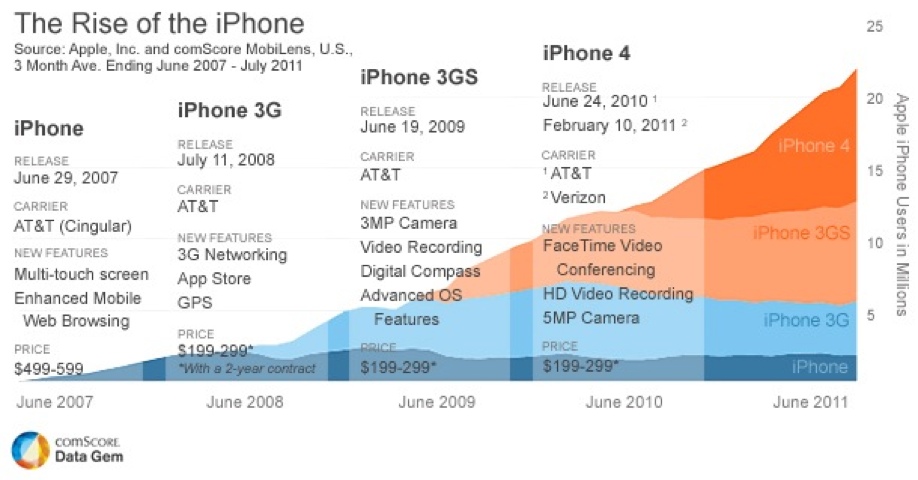Archivo de la categoría: movil
La evolución del iPhone
Llega la hora de los smartphones low-cost
Soy un teórico, lo sé, pero me encanta ver que las teorías y la metodología funciona y se cumple la sistemática… Sigue claramente la teoría de Everett Rogers de la difusión de una innovación.
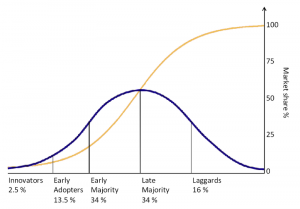 Con niveles de penetración de smartphones en el mercado de terminales cercanos al 35-40% esta claro que llega el momento de poner en marcha una estrategía de terminales de búsqueda de smartphones low-cost.
Con niveles de penetración de smartphones en el mercado de terminales cercanos al 35-40% esta claro que llega el momento de poner en marcha una estrategía de terminales de búsqueda de smartphones low-cost.
Y esto es una buena noticia para operadores, fabricantes y clientes finales. A los operadores porque han de hacer un menor esfuerzo económico en el subsidio de terminales, a los fabricantes ya que comenzamos a llegar a la etapa en la que esta tecnología se va a acoger por el «mass market» y a los clientes por que por fin llega una oferta de terminal (que es conocido que es el factor de decisión aún más importante para motivar el contratar una línea con un operador) al mercado que se ajuste a todos los bolsillos.
Primero se rumorea que Apple sacará un iPhone reducido y más barato hace semanas.
Nokia parece que saca sus nuevos smartphones 600, 700 y 701 con Symbian Belle OS, la última actualización de Anna, que se situan entre los 180€-290€ . Traen pantalla de 6″ customizable con widgets, soporte para NFC embebido en el OS.
Samsung por su lado se plantea ofrecer oferta de terminales alrededor de los $200 de PVP sin subsidio en este segmento (sobre lo que estaba ya hoy el Samsung Galaxy Mini). Samsung asimismo ha acertado a mi juicio con el naming de sus nuevo line-up Galaxy basados en Android 2.3: S significa Super Smart, R de Royal, W de Wonder, M de Magical e Y de Young. Especialmente interesantes son estos 2 últimos están orientados a público joven y que busca un terminal barato. Samsung usará «Pro» para indicar un teclado qwerty, «Plus» para los upgrade de dispositivo y «LTE» los 4G.
La batalla esta sólo comenzando en este segmento.
Por cierto, y aparte, interesante ver que el porcentaje de penetración de Android 2.3 ya es muy importante, muestra de que el parque de terminales se va actualizando, existe demanda de él y Froyo va poco a poco desapareciendo:
 Recordemos que 2.3 incorpora cliente SIP integrado, NFC (muy chulo pero requieres que el móvil además tenga en chip, que no es el caso en esta categoría de Samsung), Download manager y soporte para múltiples cámaras, aparte de mejoras en la usabilidad, user interface y rendimiento general.
Recordemos que 2.3 incorpora cliente SIP integrado, NFC (muy chulo pero requieres que el móvil además tenga en chip, que no es el caso en esta categoría de Samsung), Download manager y soporte para múltiples cámaras, aparte de mejoras en la usabilidad, user interface y rendimiento general.
Android esta semana
Me apetece volver a bloguear después de un tiempo de estudio y quizá falta de orientación.
Empiezo hoy una sección en el blog que pretendo mantener para seguir esta tendencia en detalle:
1) Handsets vendors scorecard en US
Apple supera en ventas a Nokia en el segmento de smartphones pero no en ventas totales. Samsung y Nokia son los gallitos en ventas totales a mucha distancia del resto. RIM y Motorola han perdido coba en las batallas Android y tablets y lo están notando.
Table 1: Mobile Device Vendors Q2 Scorecard
| Apple (Q3) | Samsung | Nokia | LG | |
| Handsets Shipped | 20.34 million iPhones; 9.25 million iPads | Did not report. (estimated 74 million) | 88.5 million | 24.8 million |
| Handset Sales | $13.3 billion | $11.08 billion | €5.5 billion (US$7.8 billion) | $3 billion |
| Average Selling Price | iPad: $654 | Up 10 percent | Did not report. | Did not report. |
| Most Notable Launch | iPad 2 | Galaxy Tab 10.1 & Nexus S | N9 MeeGo phone | Optimus 2X |
| Most Anticipated Launch | iPhone 5 | Stratosphere LTE for Verizon Wireless | Sea Ray, the first Windows Phone smartphone | LG Thrill 3D for AT&T |
| Total annual handsets unit sell-through* | 6 percent | 23 percent | 29 percent | 8 percent |
| *Pyramid Research’s projected number of total handsets sold to end consumers by the end of 2011. | ||||
2) Ice Cream Sandwich será la versión que unificará las versiones de Android de móviles y tablets – Final de 2011 –
Se rumorea que Google escogerá Texas Instruments como chipset (como fue Nvida con el Tegra 2 para Android 3.0 HoneyComb). Esto hará que los posibles primeros terminales puedan ser seguramente LG (como mucho recorrido con el chipset OMAP de TI) o Samsung (con alguno menos).
3) Skype amplia la lista de terminales Android compatibles con videollamadas – incluye Galaxy S y S2
4) Más del 24% de los dispositivos ya tienen Gingerbread
Esta llegando a algunos operadores para Galaxy S, y Xoom y Samsung 10.1 se actualizan estos días a Gingerbread.
5) WIMM, los módulos wearables con Android, el próximo mercado Android – ya en la calle
Ya se han visto cosas parecidas en el pasado (Sony Ericsson LiveView o los recientes i’m Color o i’m Jewel) pero WIMM no es lo mismo. Los anteriores eran dispositivos vinculados a nuestros teléfonos Android mientras los WIMM disponen de una CPU de 667MHz, Wi-Fi, Bluetooth, GPS, acelerómetro, magnetómetro, vibrador, altavoz, y 32GB de memoria en una microSD. Con todo esto, este pequeño gadget no es un esclavo del teléfono, sino que es un dispositivo por cuenta propia
WIMM Labs es una start-up formada por gente que trabajó en empresas tan importantes como Rambus, Dell, Palm, Roku, Opera o Electronics Arts. La idea que tiene la joven empresa americana es la de crear una plataforma llamada WIMM que lleve Android a los dispositivos tan pequeños que puedan ir hasta en nuestra muñeca, o que se puedan introducir en otros gadgets.
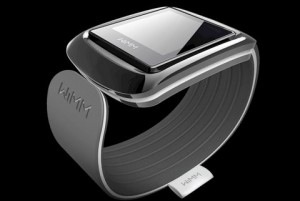
Con 32 x 36 x 12,5 mm (1,3 x 1,4 x 0,5 pulgadas) de tamaño y un peso de 22g, los módulos de la “Wimm” tienen por objeto la integración en una amplia gama de productos y usos, que van desde su uso como colgantes y llaveros para montaje en el manillar de bicicleta, para incrustar en las carteras o aparatos electrónicos, podómetros, etc.
6) Blackberry Playbook no ejecutará apps Android hasta Otoño – se retrasa de nuevo
7) Otros – Huawei saca el Vision – Vodafone y Orange sacan el Samsung Tab 10.1 desde 199EUR en VF el modelo sólo Wifi. Tb disponible el modelo 3G a 499EUR. – Samsung 8.9 esta disponible para ser reservado por 700EUR en Amazon el modelo con 3G.- Vodafone Turquía comienza un servicio de soporte para smartphones a usuarios
iPhones e iPad dinamizan Wifi mientras Android dinamiza 3G/4G
Esto es lo que se desprende de un estudio publicado hoy por ComScore del que se desprende que los usuarios de iOS consumen más tráfico desde conexiones Wifi, mientras que los usuarios de smartphones y tablets Android consumen más 3G. En concreto la distribución de tráfico se 3G vs Wifi para cada familia de dispositivos se ve en la siguiente gráfica:
Estos datos viene a confirmar los datos publicados la semana pasada por Nielsen en los que se reflejaba que los usuarios de Android consumen más tráfico 3G de sus bonos en USA que los usuarios de otros sistemas operativos (582MB/mes en Android vs 492 de usuarios con iOS o 127MB de BBOS)
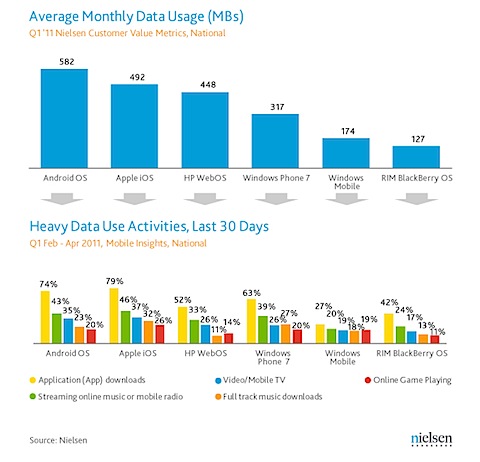
Los datos de consumos medios aún están lejos los consumos que se ven hoy en España pero sin duda es la tendencia que debemos tener en cuenta ya que es que lo tendremos aquí en España quizá en 1 año o menos.
Posibles explicaciones a que esto ocurra podría ser:
– Que las actualizaciones de Android se puedan hacer en muchos casos vía wireless (no me convence demasiado la idea)
– Restricciones de iOS: que la videoconferencia de Facetime sólo funcione bajo Wifi, que los ficheros de más de 20MB de iTunes no se puedan bajar tampoco nada más que por Wifi, etc. (tampoco me convence)
– Los Widgets de Android: esta sí parece una buena explicación y esa sincronización de cuentas activada por defecto en algunos Android.
– Que Android tiene Tethering disponible hace más tiempo que iOS, por lo que se usan más Android como HotSpot wifi que dispositivos iOS. En esto cambien creo.
En contraposición lo que no me cuadra demasiado es que estos días veíamos que el mayor consumo desde móvil es ya sobre las aplicaciones y Android en esto juega en desventaja (unas 100.000 apps en Android Market vs unas 300.000 en la App Store a día de hoy). Seguramente la ley de Pareto sea la explicación a todo esto y al final ele 20% de las aplicaciones son las que generan prácticamente todo el tráfico móvil.
Fuente: http://gigaom.com/mobile/iphones-ipads-thrive-on-wi-fi-androids-on-3g-and-4g/
El consumo de datos desde los smartphones ya es más alto desde Apps que navegación web en US
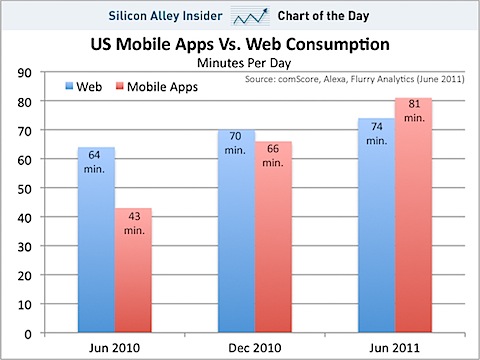
Según un estudio publicado ayer por la consultora Flury y basado en datos de publicados por Comscore y Alexa, el consumo en minutos realizado desde teléfonos ya es superior al tráfico de navegación web. Conclusión: los operadores deben fomentar la adopción de smartphones y a continuación el uso de Apps entre sus usuarios para dinamizar el tráfico de datos con información sobre las Apps existentes, info su buen uso y formación en su manejo en lo posible. Con ello conseguirán eliminar barreras de entrada y que esta innovación sea acogida por el mayor público posible.
Asimismo interesante el gráfico con los porcentajes de utilización por categorías de Apps:
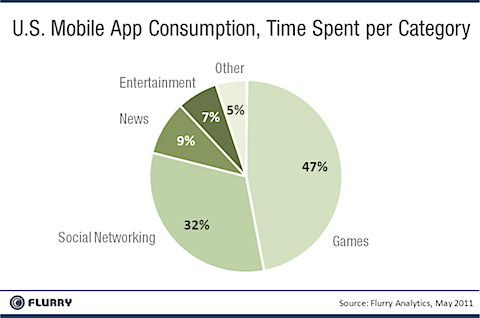
Juegos: por el momento el nº de Apps juegos que hacen uso de datos móviles es mínimo (por no decir inexistente). Sin embargo esta es una de las líneas claras que se deben desarrollar en el mercado ya a corto plazo para generar más tráfico de red, como se están desarrollando ya iniciativas como PS3 Network, Xbox Live en el mundo de las consolas o Onlive en el mundo de los juegos como streaming.
Fuente: http://blog.flurry.com/bid/63907/Mobile-Apps-Put-the-Web-in-Their-Rear-view-Mirror
Menú “secreto” en Android para troubleshooting
Sinceramente no lo conocía, lo he descubierto hoy y me parece muy práctico.
Aparece una pantalla en la que podemos tener información del terminal Android, en la que podemos hacer ping’s desde el equipo para ver si conectividad, forzar el tipo de red en la que estamos (CDMA o GSM), etc. La idea es parecida al menú secreto de iPhone para iOS antiguas “*3001#12345#*”
Muy muy útil, pruébenlo…
Ingresos y gastos de las Top 10 del mercado móvil
Brutal mail de Stephen Elop reconociendo la delicada situación de Nokia
Nokia CEO Stephen Elop rallies troops in brutally honest ‘burning platform’ memo? (update: it’s real!)
Link: http://www.engadget.com/2011/02/08/nokia-ceo-stephen-elop-rallies-troops-in-brutally-honest-burnin/
Hello there,
There is a pertinent story about a man who was working on an oil platform in the North Sea. He woke up one night from a loud explosion, which suddenly set his entire oil platform on fire. In mere moments, he was surrounded by flames. Through the smoke and heat, he barely made his way out of the chaos to the platform’s edge. When he looked down over the edge, all he could see were the dark, cold, foreboding Atlantic waters.
As the fire approached him, the man had mere seconds to react. He could stand on the platform, and inevitably be consumed by the burning flames. Or, he could plunge 30 meters in to the freezing waters. The man was standing upon a «burning platform,» and he needed to make a choice.
He decided to jump. It was unexpected. In ordinary circumstances, the man would never consider plunging into icy waters. But these were not ordinary times – his platform was on fire. The man survived the fall and the waters. After he was rescued, he noted that a «burning platform» caused a radical change in his behaviour.
We too, are standing on a «burning platform,» and we must decide how we are going to change our behaviour.
Over the past few months, I’ve shared with you what I’ve heard from our shareholders, operators, developers, suppliers and from you. Today, I’m going to share what I’ve learned and what I have come to believe.
I have learned that we are standing on a burning platform.
And, we have more than one explosion – we have multiple points of scorching heat that are fuelling a blazing fire around us.
For example, there is intense heat coming from our competitors, more rapidly than we ever expected. Apple disrupted the market by redefining the smartphone and attracting developers to a closed, but very powerful ecosystem.
In 2008, Apple’s market share in the $300+ price range was 25 percent; by 2010 it escalated to 61 percent. They are enjoying a tremendous growth trajectory with a 78 percent earnings growth year over year in Q4 2010. Apple demonstrated that if designed well, consumers would buy a high-priced phone with a great experience and developers would build applications. They changed the game, and today, Apple owns the high-end range.
And then, there is Android. In about two years, Android created a platform that attracts application developers, service providers and hardware manufacturers. Android came in at the high-end, they are now winning the mid-range, and quickly they are going downstream to phones under €100. Google has become a gravitational force, drawing much of the industry’s innovation to its core.
Let’s not forget about the low-end price range. In 2008, MediaTek supplied complete reference designs for phone chipsets, which enabled manufacturers in the Shenzhen region of China to produce phones at an unbelievable pace. By some accounts, this ecosystem now produces more than one third of the phones sold globally – taking share from us in emerging markets.
While competitors poured flames on our market share, what happened at Nokia? We fell behind, we missed big trends, and we lost time. At that time, we thought we were making the right decisions; but, with the benefit of hindsight, we now find ourselves years behind.
The first iPhone shipped in 2007, and we still don’t have a product that is close to their experience. Android came on the scene just over 2 years ago, and this week they took our leadership position in smartphone volumes. Unbelievable.
We have some brilliant sources of innovation inside Nokia, but we are not bringing it to market fast enough. We thought MeeGo would be a platform for winning high-end smartphones. However, at this rate, by the end of 2011, we might have only one MeeGo product in the market.
At the midrange, we have Symbian. It has proven to be non-competitive in leading markets like North America. Additionally, Symbian is proving to be an increasingly difficult environment in which to develop to meet the continuously expanding consumer requirements, leading to slowness in product development and also creating a disadvantage when we seek to take advantage of new hardware platforms. As a result, if we continue like before, we will get further and further behind, while our competitors advance further and further ahead.
At the lower-end price range, Chinese OEMs are cranking out a device much faster than, as one Nokia employee said only partially in jest, «the time that it takes us to polish a PowerPoint presentation.» They are fast, they are cheap, and they are challenging us.
And the truly perplexing aspect is that we’re not even fighting with the right weapons. We are still too often trying to approach each price range on a device-to-device basis.
The battle of devices has now become a war of ecosystems, where ecosystems include not only the hardware and software of the device, but developers, applications, ecommerce, advertising, search, social applications, location-based services, unified communications and many other things. Our competitors aren’t taking our market share with devices; they are taking our market share with an entire ecosystem. This means we’re going to have to decide how we either build, catalyse or join an ecosystem.
This is one of the decisions we need to make. In the meantime, we’ve lost market share, we’ve lost mind share and we’ve lost time.
On Tuesday, Standard & Poor’s informed that they will put our A long term and A-1 short term ratings on negative credit watch. This is a similar rating action to the one that Moody’s took last week. Basically it means that during the next few weeks they will make an analysis of Nokia, and decide on a possible credit rating downgrade. Why are these credit agencies contemplating these changes? Because they are concerned about our competitiveness.
Consumer preference for Nokia declined worldwide. In the UK, our brand preference has slipped to 20 percent, which is 8 percent lower than last year. That means only 1 out of 5 people in the UK prefer Nokia to other brands. It’s also down in the other markets, which are traditionally our strongholds: Russia, Germany, Indonesia, UAE, and on and on and on.
How did we get to this point? Why did we fall behind when the world around us evolved?
This is what I have been trying to understand. I believe at least some of it has been due to our attitude inside Nokia. We poured gasoline on our own burning platform. I believe we have lacked accountability and leadership to align and direct the company through these disruptive times. We had a series of misses. We haven’t been delivering innovation fast enough. We’re not collaborating internally.
Nokia, our platform is burning.
We are working on a path forward — a path to rebuild our market leadership. When we share the new strategy on February 11, it will be a huge effort to transform our company. But, I believe that together, we can face the challenges ahead of us. Together, we can choose to define our future.
The burning platform, upon which the man found himself, caused the man to shift his behaviour, and take a bold and brave step into an uncertain future. He was able to tell his story. Now, we have a great opportunity to do the same.
Stephen.
La biblia de BlackBerry
Super interesante. Todo lo que necesitas conocer sobre tu BlackBerry.


